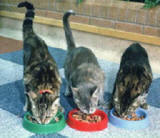|
Need Help?
|
|
Call
1-800-372-3706
to
speak to a Veterinary Behavior Technician |
|
Paws To Speak!
Member Main Menu
|
|
 |
 |
|
Help is at your
fingertips by library, email,
and phone. |
Learn more...
Pet Selection

World's Oldest Cat
The Guinness Book of
World Records confirmed that Grandpa, who appeared in the March 1997 Cat Fancy
centerfold,
was the world's
longest-living cat. Grandpa,
who died on
April 1, 1998,
lived to be 34
years.


|
Cat
Selection - One Cat, Two Cats, Three
Cats, More?
What is it?
Cat selection is a process
of evaluating the best cat
personality, age, and type
for your household.
Contrary to popular opinion,
cats are social animals. Sometimes two cats do better
than just one, but not
always. Cats, unlike dogs,
are solitary hunters. What's the point?
If you decide to
add a second cat to your
family, it's better to
"foster" a second cat or
kitten first to see if your
cat and the new cat like
each other. Yes, cats have
good and bad chemistry with
other feline individuals.
Some cats are more flexible
and interested in a second
cat than others. If your cat
was socialized to other
kittens in the first two
months of life, your cat
will be more likely to
accept a feline stranger
into the family.
|
If you decide to add a
second cat to your family,
it's better to "foster" a
second cat or kitten first
to see if your cat and the
new cat like each other.
|
Add Resources
Because cats are
solitary hunters, it is
important that you add
enough "resources" when
adding a second cat to avoid
territorial aggression. This
means have ample food, toys,
cat beds, litter boxes, and
space to help multiple cats
to share nicely.
Pet Selection
How a family selects a pet
makes a big difference in
the potential for a long
lasting, great relationship.
Think about it. Pets live
with you for up to two
decades. Would you ever pick
a room-mate or marry someone
you didn't know well?
How do you know if, in the
long run, a new pet will be
compatible with your family
and life-style? It's
hard to know in advance how
your cat will
respond to a new roommate.
For your education...
Feline Adolescence
-
17 weeks
to
1 year
Social play lessons.
Continue interactive
play sessions with play
directed to toys not to
human feet or fingers.
Seeks social status
by challenges cats in
the household. May
subordinate to larger
adult cats.
Spraying may occur -
less likely if altered
or if only cat. Provide
tall posts and praise
cheek marking. Upgrade
to larger litter box -
scooped 2x daily.
|
"Helping you raise a fabulous feline
friend for life." |
|